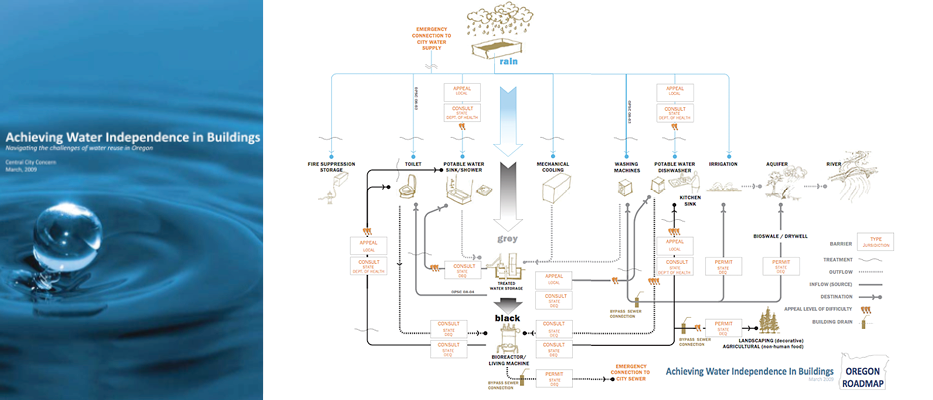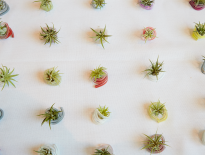Arch|Nexus SAC: Leading By Example
The Arch Nexus design firm’s Sacramento office (Arch|Nexus SAC) is not only the world’s first Living Building to be an adaptive reuse of an existing building, but also the first to receive LBC 3.0 certification, the first Living Building in California, the first Living Building to be owned and operated by a design firm, and the first LEED v4 Double-Platinum building (BD+C & O+M) on the planet.
In 2008, just after the onset of the Great Recession, we realized that the best thing we could do for our business was to move from leasing space to owning it. Real estate deals were abundant, and we were fortunate to be able to find an existing building to adaptively reuse that was a little larger than we needed for a reasonable price. Ultimately, we created Arch|Nexus SLC (aka the Architectural Nexus Design Center) which earned LEED v3 BD+C Platinum in 2011.
The decision to own our own building rather than lease was based on several factors. Owning increases our assets and builds share value. It also stabilizes long-term costs as compared to fluctuating (and increasing) rent costs. In addition to these direct financial advantages, owning also allows us an opportunity to create a physical manifestation of our core values.
The process of owning and operating our own building was a crucible for sure. We experienced several months of service calls and comfort issues. The requisite systems training and building commissioning were weak at best, and we were left with the realization that it was up to us to get the building operating properly.
In the end, the result was transformative. The process of designing and building a high-performance office that earns LEED Platinum but wasn’t performing up to our expectations was actually an enormous learning opportunity. We began to tackle the operational challenges one by one. Through this process, we discovered that the greatest disparity between predicted and actual performance was with the occupants themselves. With some effort, the building and the occupants were on the same page and the project earned LEED v3 O+M Platinum in 2014. Since then our Energy Star score has continued to climb through thoughtful occupant engagement strategies.
Key Element #1
As operations in our Salt Lake City office fell into alignment with its design, a few additional key elements fell into place that would set the stage for Arch|Nexus SAC. First, there was a client tour right after we moved in that went awry when someone asked about water reuse. We hadn’t addressed it at all and I had no good answer beyond a lack of understanding as to the status of regulation on the topic. Another local design firm had dipped their foot into water reuse, so to speak, and the State Legislature had brought down the hammer by capping the size of rainwater storage systems throughout the State of Utah as a result.
In order to both better understand and answer the water reuse question, I attended a seminar at GreenBuild 2011 on the topic. The group that was working on the Oregon Sustainability Center presented a transformative document they had put together entitled Achieving Water Independence in Buildings. This document included the Oregon Roadmap, a graphic description of water reuse paths and the regulatory obstacles, or lack thereof, for each.

This was the spark that ignited my imagination. While I knew of the International Living Future Institute and the Living Building Challenge before, this is when I began to understand regenerative design. I put together a small group of like-minded individuals to create the Utah Roadmap and in 2012 I became an Ambassador for ILFI. I like to think that this is when I started the second half of my career.
Key Element #2
Still in the midst of the Great Recession, Anova Architects, an incredible group of folks with deep roots in Sacramento, the Central Valley, and throughout the foothills of the Sierra joined our family through a merger in 2011. We quickly got to know each other and then we patiently waited for the economy in California’s Central Valley to turn around. We were largely buoyed up by large federal projects at the time, but as those ended our experience of the Recession deepened. It was during this time that I became the President of Arch Nexus in 2014.
As President, my first task was to address our identity and our culture. This process was introspective at the individual and firm level. As a company that developed by merger, Arch Nexus was a diverse partnership of 20+ Principals in a variety of markets that, like most business enterprises, hadn’t really come together around a common purpose other than the business itself. Over the course of several retreats, we rebranded the firm, launched a new graphic identity and website, and developed an understanding of our common goals. Through a series of leadership meetings, we identified three core values that we believe are the purpose for our business:
Arch Nexus Values:
- Inspiration
- Stewardship
- Regeneration
By early 2015 we were doing well financially, had plenty of backlog in both offices, and were growing again. Coincidentally our lease space in Sacramento was down to a handful of open workstations due to modest growth. As an employee-owned company, we had been looking for strategies to reinvest in ourselves in order to build share value without focusing on artificial growth through mergers and acquisitions.
All of this was occurring within the context of global climate change and the final key element that made Arch|Nexus SAC possible presented itself. The Spring of 2015 represented the point at which the nation was becoming aware of the dire situation in California. Our collective consciousness was beginning to recognize just how much things had changed as a result of the water and energy decisions we were making as a society. Decisions that we, as architects, were fueling as an industry.
Sensing that the real estate market in Sacramento was starting to bounce back, I asked our firm to do something audacious. I suggested that the timing was right to buy another building for us to regenerate and operate. But this time, we needed to do something truly bold; LEED Double-Platinum was no longer enough. I suggested that the following three factors guide our decision-making on the topic:
- Capacity
- Equity
- Identity
By increasing our presence in Sacramento, by providing equivalent resources and amenities to those provided at Arch|Nexus SLC, and by creating another physical manifestation of our stated values, we were poised to break barriers. As a firm, we decided to pursue ILFI’s Living Building Challenge certification with Zero Energy certification as our minimum expectation.
Achieving Living Building Certification is a testament to the grit that makes us who we are at Arch Nexus. The road was fraught with challenges and many people rose to the occasion. This story, however, is about how we made the opportunity for those heroics to happen, not the heroes themselves.
Make no little plans; they have no magic to stir [the] blood and probably themselves will not be realized. Make big plans; aim high in hope and work, remembering that a noble, logical diagram once recorded will never die, but long after we are gone will be a living thing, asserting itself with ever-growing insistency. Remember that our [progeny] are going to do things that would stagger us. Let your watchword be order and your beacon beauty.



